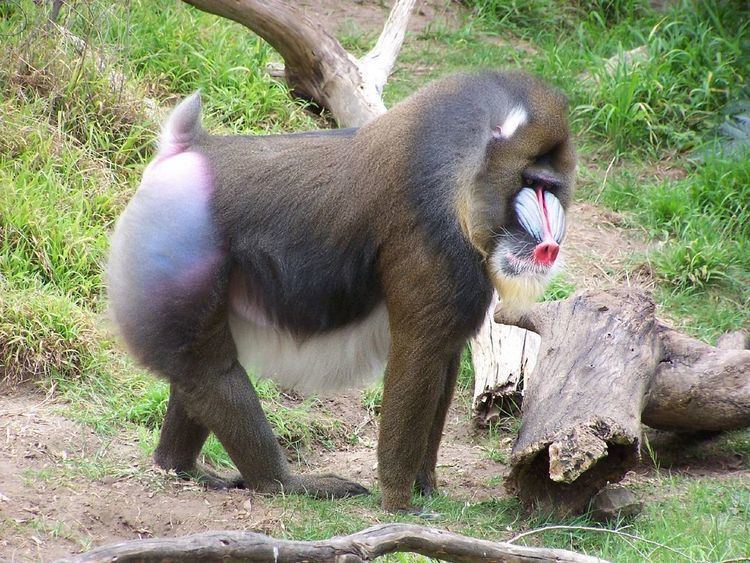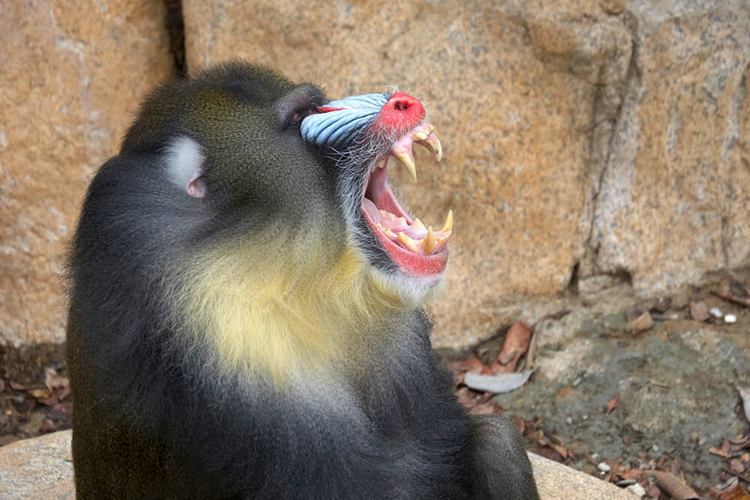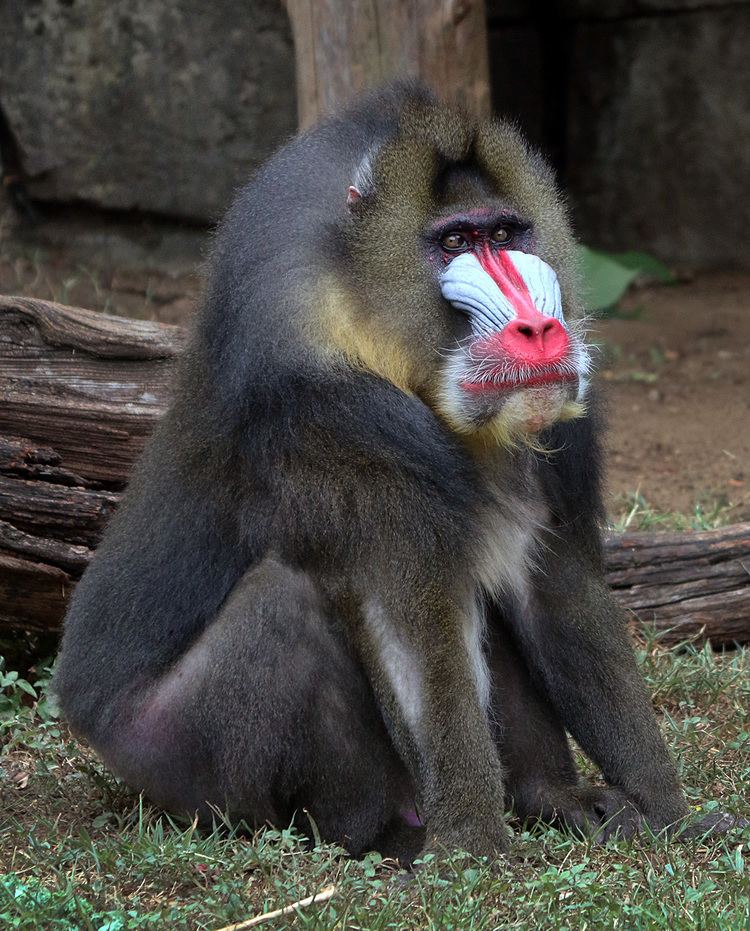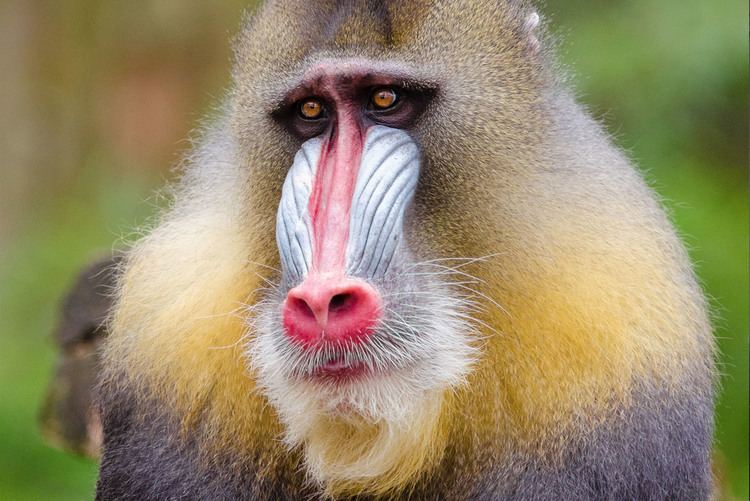Phylum Chordata Family Cercopithecidae | ||
 | ||
Mandrills very colorful monkeys
The mandrill (Mandrillus sphinx) is a primate of the Old World monkey (Cercopithecidae) family. It is one of two species assigned to the genus Mandrillus, along with the drill. Both the mandrill and the drill were once classified as baboons in the genus Papio, but they now have their own genus, Mandrillus. Although they look superficially like baboons, they are more closely related to Cerocebus mangabeys. Mandrills are found in southern Cameroon, Gabon, Equatorial Guinea, and Congo. Mandrills mostly live in tropical rainforests. They live in very large groups. Mandrills have an omnivorous diet consisting mostly of fruits and insects. Their mating season peaks in July to September, with a corresponding birth peak in December to April.
Contents
- Mandrills very colorful monkeys
- Wild mandrill monkeys encounter in lekedi gabon
- Description
- Ecology and activities
- Social behavior and reproduction
- Status and conservation
- References

Mandrills are the world's largest monkeys. Charles Darwin wrote in The Descent of Man that "no other member in the whole class of mammals is coloured in so extraordinary a manner as the adult male mandrill's". The mandrill is classified as vulnerable by IUCN.

Wild mandrill monkeys encounter in lekedi gabon
Description

The mandrill has an olive green or dark grey pelage with yellow and black bands and a white belly. Its hairless face has an elongated muzzle with distinctive characteristics, such as a red stripe down the middle and protruding blue ridges on the sides. It also has red nostrils and lips, a yellow beard and white tufts. The areas around the genitals and the anus are multi-colored, being red, pink, blue, scarlet, and purple. They also have pale pink ischial callosities. The coloration of the animal is more pronounced in dominant adult males. Both sexes have chest glands, which are used in olfactory communication. These, too, are more prominent in dominant adult males. Males also have longer canines than females, with an average of 4.5 cm (1.8 in) and 1.0 cm, respectively.

The mandrill is one of the most sexually dimorphic mammals due to extremely strong sexual selection which favors males in both size and coloration. Males typically weigh 19–37 kg (42–82 lb), with an average mass of 32.3 kg (71 lb). Females weigh roughly half as much as the male, at 10–15 kg (22–33 lb) and an average of 12.4 kg (27 lb). Exceptionally large males can weigh up to 54 kg (119 lb), with unconfirmed reports of outsized mandrills weighing 60 kg (130 lb) per the Guinness Book of World Records. The mandrill is the heaviest living monkey, somewhat surpassing even the largest baboons such as chacma baboon and olive baboons in average weight even considering its more extreme sexual dimorphism, but the mandrill averages both shorter in the length and height at the shoulder than these species. The average male is 75–95 cm (30–37 in) long and the female is 55–66 cm (22–26 in), with the short tail adding another 5–10 cm (2–4 in). The shoulder height while on all fours can range from 45–50 cm (18–20 in) in females and 55–65 cm (22–26 in) in males. Compared to the largest baboons, the mandrill is more ape-like in structure, with a muscular and compact build, shorter, thicker limbs that are longer in the front and almost no tail. Mandrills can live up to 31 years in captivity. Females reach sexual maturity at about 3.5 years.
Ecology and activities

The mandrill is found in Nigeria, southern Cameroon, Gabon, Equatorial Guinea, and Congo. Its distribution is bounded by the Sanaga River to the north and the Ogooué and White Rivers to the east. Recent research suggests that mandrill populations north and south of the Ogooué river are so genetically different as to be separate subspecies. Mandrills live in tropical rainforests. They also live in gallery forests adjacent to savannas, as well as rocky forests, riparian forests, cultivated areas and flooded forests and stream beds. Mandrills will cross grass areas within their forest habitats.

The mandrill is an omnivore. It usually consumes plants, of which it eats over a hundred species. It prefers to eat fruits, but will also eat leaves, lianas, bark, stems, and fibers. It also consumes mushrooms and soil. Carnivorously, mandrills mostly eat invertebrates, particularly ants, beetles, termites, crickets, spiders, snails, and scorpions. It will also eat eggs, and even vertebrates such as birds, tortoises, frogs, porcupines, rats, and shrews. Mandrills likely will eat larger vertebrates when they have the opportunity, such as juvenile bay duikers and other small antelope. Large prey are likely killed with a bite to the nape with the mandrill's long canines. One study found the mandrill's diet was composed of fruit (50.7%), seeds (26.0%), leaves (8.2%), pith (6.8%), flowers (2.7%), and animal foods (4.1%), with other foods making up the remaining (1.4%).
Mandrills are preyed on mainly by leopards. Additional predators known to attack both adult and young mandrills include crowned eagles and African rock pythons. They may be bitten and killed by Gaboon vipers when they accidentally rouse the venomous snake. It is thought that most predators are a threat mainly to young mandrills, with the likelihood of predation decreasing in adult females and especially adult males, which may be invulnerable to all but the seldom ambush by a leopard. In a study where a mandrill troop was exposed to stimuli relating to their natural predators, only the leopard caused the larger part of the group to flee into trees. However, the large, dominant males were observed to remain in response to the images of the natural predators, even the leopard, and pace back and forth whilst baring their teeth, generally indicating aggression and the defensive role they may play in such circumstances.
Mandrills are mostly terrestrial but they are more arboreal than baboons and feed as high as the canopy. When on the ground, mandrills walk by digitigrade quadrupedalism (walking on the toes of all four limbs). When in the trees, they often move by lateral jumps. Mandrills are mostly diurnal, with activities extending from morning to evening. They sleep in trees at a different site each night. Mandrills have been observed using tools; in captivity, mandrills have been observed using sticks to clean themselves.
Social behavior and reproduction
Mandrills seem to live in very large, stable groups named 'hordes'. A horde can number in the hundreds of mandrills, possibly averaging around 615 individuals and reaching as many as 845. It is difficult to accurately estimate horde size in the forest, but filming a horde crossing a gap between two forest patches or crossing a road is a reliable way of estimating the total number. The largest horde verifiably observed in this way contained over 1,300 individuals, in Lopé National Park, Gabon—the largest aggregation of nonhuman primates ever recorded. These hordes are made of adult females and their dependent offspring. Males live a solitary lifestyle, and only enter hordes when females are receptive to mating, which lasts three months each year. All-male bachelor groups are not known to exist.
The mating season of the mandrill takes place from June to October, which is when the sexual swellings of the female occur. They breed every two years. When breeding, a male will follow and guard a female in estrus. Adult males exist in two different forms: the brightly colored and "fatted" dominant males, and the paler and "nonfatted" subordinate males. Both males engage in mating, but only the dominant males can sire offspring. Males sometimes fight for breeding rights which results in dominance. Though conflicts are rare, they can be deadly. Gaining dominance, that is becoming the alpha male, results in an "increased testicular volume, reddening of sexual skin on the face and genitalia, and heightened secretion of the sternal cutaneous gland". When a male loses dominance or its alpha status, the reverse happens, although the blue ridges remain brightened. There is also a fall in its reproductive success. This effect is gradual and takes place over a few years. When subordinates mate-guard a female, the competition between them allows the dominant males to have a greater chance of siring offspring, since subordinates outnumber dominants 21 to 1. There is also a dominance hierarchy among females, with reproductive success being displayed in shorter interbirth intervals amongst these alpha figures and the beginning of reproduction at earlier ages.
Mandrill births occur from January to May. Most births in Gabon occur in the wet season, from January to March, and gestation usually lasts 175 days. In captivity, 405 days separate each birth. Young are born with a black natal coat and pink skin. The females do most of the raising of the young. Alloparenting exists in this species, with female relatives providing care for the young. Males leave their natal groups when they are six years old and stay along the boundary of the social group.
Mandrills will make a "silent, bared-teeth face", in which the teeth are bared, the head crest is erect and the head shakes. This may serve as a peaceful form of communication. A mandrill submits by presenting its rump. With aggression, mandrills will stare, bob their heads, and slap the ground. Vocalizations like roars, crowings, and "two-phase grunts" are made for long distances, while "yaks", grunts, "k-alarms", "k-sounds", screams, girneys, and grinds are made at short distances.
Status and conservation
The mandrill is considered vulnerable and is affected by deforestation. However, hunting for bushmeat is the more direct threat. Mandrills are particularly threatened in the Republic of the Congo. Nevertheless, there have been captive-bred individuals that have been successfully reintroduced into the wild.
